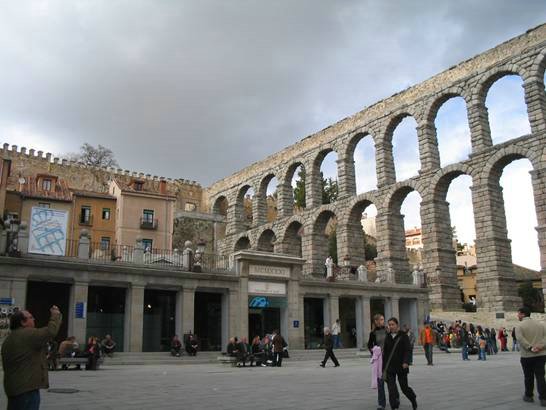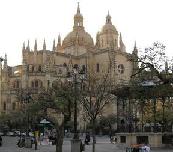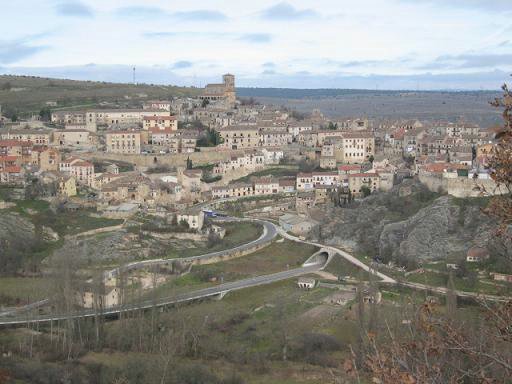Segovia is one of Spain's most famous historic cities. It is located in the Castilla and León region just half an hour's drive from Madrid. The collection of historical monuments, their conservation together with its beauty make this an impressive city to visit. It was delared a World Heritage Site in 1985. See photos of Segovia.
Some of the surrounding villages, entrapped in small valleys within the canyons of the River Doratón also have superb Roman historical monuments to see. Segovia is a relatively small province and you can get to most of the nearby well known villages very easily but for those looking for something more peaceful off the main tourist route there are a number of lesser known but equally interesting villages which offer accommodation in rural hotels.
Segovia is a province of great contrasts. It covers 7000 km2 and rises to 2500 metres above sea level in its mounta¡nous areas and drops to 750 metres in its lowest areas. The province borders with the south of Madrid, the north of Burgos and Valladolid, the east of Soria and the west of Ávila and Guadalajara.
The climate: Segovia has a stable climate with cold winters and hot summers, very typical for Castilla and Leon. It does not have very extreme temperatures unlike other areas further north. The average temperature is between 10 and 20 degrees although this may drop in the higher areas.
Fiestas in Segovia: The fiestas take place on
25th Octuber, San Frutos. And there are fiestas to celebrate San Juan in June
(24th to 30th). The Easter processions in Segovia are famous throughout Spain.
There is also a well known puppet theatre festival in Segovia in May called Titirimundi in which almost 100 puppet theatre companies from all over the world participate.
 The Aquaduct: This is Segovia's best
known historical monument, clearly visiblefrom the outskirts of the city.It was built towards the end of 1 A.D. It measures 800 metres and at its highest
point it reaches 28 metres, in the la Plaza del Azoguejo. This impressive piece
of Roman engineering has 166 arches and 120 columns on two levels. Until relatively
recently it was still in use and is probably one of the best conserved Romanaquaducts
in the world.
The Aquaduct: This is Segovia's best
known historical monument, clearly visiblefrom the outskirts of the city.It was built towards the end of 1 A.D. It measures 800 metres and at its highest
point it reaches 28 metres, in the la Plaza del Azoguejo. This impressive piece
of Roman engineering has 166 arches and 120 columns on two levels. Until relatively
recently it was still in use and is probably one of the best conserved Romanaquaducts
in the world. The
Cathedral: Located in the Plaza Mayor, this beautiful Cathedral looms over
Segovia's historic centre. Itwas built in a Renaissance Gothic style in the 16th
century following the destruction of the previous Roman cathedral. It has a museum
which has the first printed book in Spain from 1472 - el Sinodal de Aguilafuente.
This Cathedral is acclaimed for both its size and beauty, designed by Juan Gil
de Hontañón, it has 3 naves with adjoining chapels on each side.
The
Cathedral: Located in the Plaza Mayor, this beautiful Cathedral looms over
Segovia's historic centre. Itwas built in a Renaissance Gothic style in the 16th
century following the destruction of the previous Roman cathedral. It has a museum
which has the first printed book in Spain from 1472 - el Sinodal de Aguilafuente.
This Cathedral is acclaimed for both its size and beauty, designed by Juan Gil
de Hontañón, it has 3 naves with adjoining chapels on each side..jpg) Alcázar
de Segovia: Located a short walk from the Cathedral, this impressive fortress
could have Roman orCeltic origins. (recent excavations have found similar stones
to those used in the construction of the aquaduct.) It was built in the 14th century
when the transiton from Roman to Gothicbegan. Alfonso el Sabio converted it into
one of his favourite residences and during the rest of the middle ages it was
still visited by the Kings of Castilla. Isabel la Católica used it as a
place to start her royal procession before being proclaimed queen in the Plaza
Mayor.
Alcázar
de Segovia: Located a short walk from the Cathedral, this impressive fortress
could have Roman orCeltic origins. (recent excavations have found similar stones
to those used in the construction of the aquaduct.) It was built in the 14th century
when the transiton from Roman to Gothicbegan. Alfonso el Sabio converted it into
one of his favourite residences and during the rest of the middle ages it was
still visited by the Kings of Castilla. Isabel la Católica used it as a
place to start her royal procession before being proclaimed queen in the Plaza
Mayor..jpg) Calle
Real: This is a pedestrianised street which joins the Plaza del Azoguejo to
the Plaza Mayor - it has lots of interesting monuments:
Calle
Real: This is a pedestrianised street which joins the Plaza del Azoguejo to
the Plaza Mayor - it has lots of interesting monuments:Segovian Gastronomy: The star of Segovian cuisine is without doubt roast meat, especially pork and lamb. There are a great number of restaurants in Segovia and the surrounding province that offer excellent roasts. Other typical dishes from the province are Castellana soup, beans, stews and trout. The cold meats are very good and the local wines have a lot of personality and are quite strong. Typical desserts are 'el ponche segoviano' and there are lots of local cakes and pastries to try (florones, tortas, rosquillos....).
Recommended Restaurants in Segovia: : Segovia's most famous restaurant is Mesón de Cándido set in a privileged location just next to the aquaduct. Candido became famous during the Franco dictatorship, and the restaurant continues specialising in roast suckling pork. Popular with tourists, it is a bit cramped as tables are very close to eachother and service very brisk. Meson Duque and Mesón José María also offer excellent roasts and have the advantage of not being as busy as Cándido. For creative and innovative cuisine Cocina de Segovia, Villena and Maracaibo-Casa restaurants are an excellent option.
Accommodation in Segovia: The city has a Parador hotel on a hill with fantastic views of the city of Segovia and all its main sights. Nevertheless the quality and the service is not really up to the standard offered by other parador hotels. For other options see Hotels in Segovia.

| Travelling to Segovia? The following links may also be useful | |
|---|---|
| Guides provinces bordering with Segovia and beautiful places in Spain nearby | |